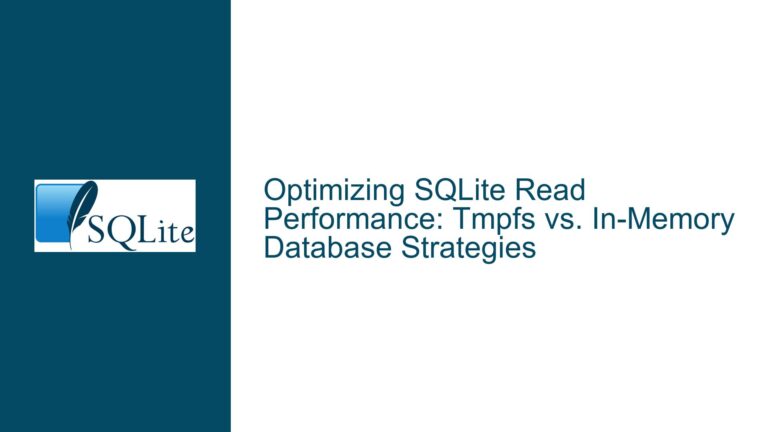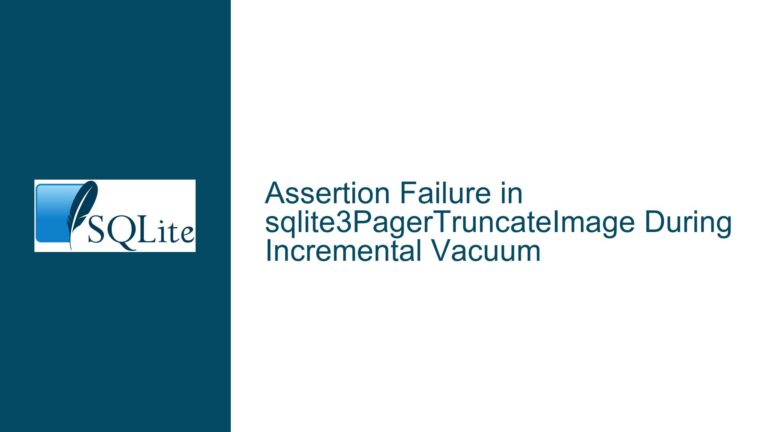SQLite Blob Updates and Fragmentation Concerns
SQLite’s Handling of Fixed-Size Blob Updates and Fragmentation
When working with SQLite as a key-value store for fixed-size blobs, a common concern arises regarding whether updating blobs of the same size will lead to database fragmentation. This issue is particularly relevant for applications that prioritize reliability and durability, where the database is pre-created and only updated, never inserted into. The core question revolves around whether SQLite will update blobs in place or if it will introduce fragmentation by reusing deleted database pages.
SQLite’s internal mechanisms for managing storage and updates are designed to optimize performance and storage efficiency. However, the behavior of these mechanisms can vary based on several factors, including the specific version of SQLite, compilation options, and even the underlying file system. Understanding these nuances is crucial for developers who need to ensure that their applications perform reliably and efficiently.
The Nature of SQLite’s Page Reuse and In-Place Updates
SQLite operates on a page-based storage model, where the database file is divided into fixed-size pages. When a blob is updated, SQLite marks the old blob’s storage space as free and allocates new space for the updated blob. In the case of fixed-size blobs, SQLite may reuse the same page for the updated blob, effectively performing an in-place update. This behavior is influenced by SQLite’s internal algorithms for managing free space and allocating pages.
However, it is important to note that SQLite does not guarantee in-place updates for blobs, even when they are of the same size. The reuse of pages and the allocation of new space are subject to change based on various factors, including the current state of the database, the presence of other concurrent operations, and the specific configuration of SQLite. As a result, while in-place updates may occur in many cases, they cannot be relied upon as a consistent behavior.
Ensuring Predictable Behavior in SQLite Blob Updates
To address the concerns of fragmentation and in-place updates, developers can take several steps to ensure more predictable behavior in their SQLite databases. One approach is to use the VACUUM command, which rebuilds the database file, reclaiming free space and reducing fragmentation. Running VACUUM periodically can help maintain the integrity and performance of the database, especially in applications with frequent updates.
Another strategy is to carefully manage the database’s page size and other configuration options. By tuning these parameters, developers can influence how SQLite allocates and reuses pages, potentially reducing the likelihood of fragmentation. Additionally, using transactions to group updates can help minimize the impact of fragmentation and improve overall performance.
In conclusion, while SQLite’s handling of fixed-size blob updates may result in in-place updates under certain conditions, this behavior is not guaranteed and can vary based on multiple factors. Developers should be aware of these nuances and take proactive steps to manage fragmentation and ensure reliable performance in their applications. By understanding SQLite’s internal mechanisms and employing best practices for database management, it is possible to achieve a high level of reliability and durability in applications that rely on SQLite as a key-value store for fixed-size blobs.
Detailed Analysis of SQLite’s Storage Model and Update Mechanisms
SQLite’s storage model is based on a B-tree structure, where data is organized into pages of a fixed size. Each page can contain multiple records, and the B-tree structure allows for efficient retrieval and modification of data. When a blob is updated, SQLite must manage the storage space previously occupied by the old blob and allocate new space for the updated blob.
In the case of fixed-size blobs, SQLite may attempt to reuse the same page for the updated blob, especially if the new blob is the same size as the old one. This reuse of pages can lead to in-place updates, where the blob is updated without requiring additional storage space. However, this behavior is not guaranteed and can be influenced by several factors, including the availability of free space within the database, the presence of other concurrent operations, and the specific configuration of SQLite.
One factor that can affect the reuse of pages is the presence of free space within the database. SQLite maintains a list of free pages that can be reused for new data. When a blob is updated, SQLite may choose to reuse a free page for the updated blob, especially if the page is the same size as the blob. However, if there are no suitable free pages available, SQLite may allocate new pages for the updated blob, potentially leading to fragmentation.
Another factor that can influence the reuse of pages is the presence of other concurrent operations. In a multi-user environment, multiple transactions may be updating the database simultaneously. In such cases, SQLite must manage the allocation and reuse of pages carefully to avoid conflicts and ensure data integrity. This management can lead to variations in the reuse of pages and the occurrence of in-place updates.
The specific configuration of SQLite can also impact the reuse of pages and the occurrence of in-place updates. SQLite provides several configuration options that can influence how it manages storage and allocates pages. For example, the PRAGMA auto_vacuum setting can be used to control whether SQLite automatically reclaims free space and reduces fragmentation. By tuning these configuration options, developers can influence the behavior of SQLite and potentially reduce the likelihood of fragmentation.
Best Practices for Managing SQLite Blob Updates and Fragmentation
To ensure predictable behavior and minimize fragmentation in SQLite databases, developers can follow several best practices. One important practice is to use the VACUUM command regularly. The VACUUM command rebuilds the database file, reclaiming free space and reducing fragmentation. By running VACUUM periodically, developers can maintain the integrity and performance of the database, especially in applications with frequent updates.
Another best practice is to carefully manage the database’s page size and other configuration options. The page size of a SQLite database can have a significant impact on performance and storage efficiency. By choosing an appropriate page size, developers can optimize the allocation and reuse of pages, potentially reducing the likelihood of fragmentation. Additionally, other configuration options, such as PRAGMA auto_vacuum and PRAGMA journal_mode, can be tuned to influence SQLite’s behavior and improve performance.
Using transactions to group updates is another effective strategy for managing fragmentation and improving performance. By grouping multiple updates into a single transaction, developers can minimize the impact of fragmentation and reduce the overhead associated with individual updates. Transactions also provide a level of atomicity and consistency, ensuring that the database remains in a valid state even in the event of errors or interruptions.
In addition to these best practices, developers should be aware of the limitations and nuances of SQLite’s storage model and update mechanisms. While SQLite is designed to be efficient and reliable, its behavior can vary based on several factors, including the specific version of SQLite, compilation options, and the underlying file system. By understanding these factors and taking proactive steps to manage fragmentation, developers can achieve a high level of reliability and durability in their applications.
Conclusion
In summary, SQLite’s handling of fixed-size blob updates can result in in-place updates under certain conditions, but this behavior is not guaranteed and can vary based on multiple factors. Developers should be aware of these nuances and take proactive steps to manage fragmentation and ensure reliable performance in their applications. By understanding SQLite’s internal mechanisms and employing best practices for database management, it is possible to achieve a high level of reliability and durability in applications that rely on SQLite as a key-value store for fixed-size blobs.






